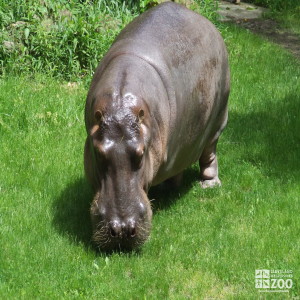Nile Hippopotamus
[Hippopotamus amphibius]

The Nile Hippopotamus is a good swimmer and diver - even graceful under water. When submerged it closes its slitlike nostrils and ears. It stays submerged for 3 to 5 minutes at a time normally, but can stay under for 15 to 20 minutes if necessary. Hearing, sight and smell are all well developed, and all function with only the top of the skull above the water surface. The incisors and canines are tusk-like and grow continuously. The incisors are rounded, smooth, and widely separated. The barrel-like body is covered by short, fine hairs, but it appears naked. All four toes on each foot support the weight of the body. The skin is glandular and exudes droplets of moisture that contain red pigment. Light reflected through this appears red, giving it the name 'blood sweat.' The weight of males ranges from 3528 to 7056 lbs. Female weight is from 1444 to 5168 lbs. Birth weight is from 60 to 110 lbs.The young can swim before they can walk, and nurse under water.
The word 'hippopotamus' is Greek for 'river horse,' although this animal is not closely related to the horse at all.
Location: Animals Formerly at Zoo
Share:
Range
The Nile hippopotamus range is Kenya, Somalia, and Tanzania.
Habitat
the Nile hippopotamus inhabits deep water with adjacent reed beds and grassland.
Conservation Status
VulnerablePrimary Threats
Human Wildlife Coexistence, Climate ChangeGestation
The Nile hippopotamus has a gestation period of 227 to 240 days.
Litter
Nile hippopotamus has one calf.
Behavior
The Nile hippopotamus is a good swimmer and diver — even graceful under water. When submerged it closes its slitlike nostrils and ears. It stays submerged for 3 to 5 minutes at a time normally, but can stay under for 15 to 20 minutes if necessary. Fights between males are vicious and can last for several hours. Many bulls have scars on their backs and bellies from such fights. Deaths are common. Bulls display and threaten by defecating while swishing the tail back and forth, creating a large cloud of fecal matter in the water. Most eating is done on land at night, often several miles from the river or lake. Hippos return to the water by dawn to spend the day digesting and resting. They have a three chamber, non-ruminating, stomach.
Reproduction
Nile hippopotamus females mate in February and August, always at the end of the dry season. The young can swim before they can walk, and nurse under water. Sexual maturity occurs at 6 to 13 years for males and 7 to 15 years for females, but in captivity both sexes mature in only 3 to 4 years.
Wild Diet
Mostly grass, aquatic plants, reeds
